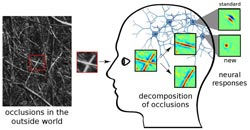A key to the world of our mind's eye

In everyday life, we often see objects occluding each other, such as a branch of a bush hiding another in this figure (red box). The image of the two objects is projected into the brain in which specialized nerve cells react to certain image traits with increased activity. To understand the image, the brain has to decompose it into its original components (here: the two branches). A new mathematical model of this decomposition now predicts that there must be many nerve cells responding to globular features in order to understand occlusions (here: new neural response). This type of cells has been observed for some time, but up to now has never been linked to visual occlusions. Figure: Jörg Lücke / Bornschein J. et al. (2013): Are V1 simple cells optimized for visual occlusions? A comparative study. PLoS Computational Biology 9(6): e1003062. <br>
The brain uses an internal model of the outer visible world to create such illusions. Frankfurt Scientists have now revealed the functionality of this “mind’s eye”. By using a new mathematical model they were able to describe the behavior of brain cells more accurately.
In contrast to previous models, this model takes into account occlusions between objects in the world. The researchers have thus shown that our brain activity is much more directly connected with the properties of the outside world than anticipated.
In 1981, the neuroscientists Hubel and Wiesel were awarded the Nobel Prize for the discovery of brain cells that react with high activity to the edges of objects in images. Their findings have shown that our brain activity is related to features such as edges of objects. Later on, mathematical models were able to explain why neurons respond to certain object features.
These models describe how the brain generates an internal image —yet, so far, they reflect rather insufficiently the actual structure of natural images. Occlusions between objects are ignored, for instance, although they are ubiquitous in the visible world. A certain type of nerve cell— only known for a few years—is difficult to be described with the current simplified models.
Researchers at the Bernstein Focus Neurotechnology Frankfurt, at the Goethe-University Frankfurt and at the Frankfurt Institute for Advanced Studies have now shown that the behavior of these new brain cells can be better characterized in computational models when further information is taken into account.
In the study, the scientists compared conventional models with one taking occlusions between objects into account. The new descriptive model was better at predicting the functional traits of this special type of nerve cells. The result also provides hints at the function of these neurons: “There are other possible explanations why there are such cells in our brain,” says Jörg Lücke, “but our results indicate the encoding of occlusions as the most plausible explanation at hand.”
The researchers involved believe that the newly acquired knowledge can crucially advance the development of automated image and video analysis technology. “We still know very little about how our brain understands and interprets images. At the same time, our brains—as well as the brains of animals—are still far superior to today's computer programs in the task of image understanding,” said Lücke. An improvement of so-called computer vision techniques would have a variety of applications. An application Lücke and colleagues are currently busy working on is the analysis of microscopy images for automated cancer detection.
This study was funded by the German Research Foundation (DFG) and within the Bernstein Focus Neurotechnology Frankfurt. Furthermore, it was supported by the Honda Research Institute Europe.
The Bernstein Focus Neurotechnology Frankfurt is part of the National Bernstein Network Computational Neuroscience in Germany. With this funding initiative, the German Federal Ministry of Education and Research (BMBF) has supported the new discipline of Computational Neuroscience since 2004 with over 170 million euros. The network is named after the German physiologist Julius Bernstein (1835-1017).
Contact:
Dr. Jörg Lücke
Bernstein Focus Neurotechnology Frankfurt and
Frankfurt Institute for Advanced Studies
Goethe-Universität Frankfurt
Ruth-Moufang-Straße 1
60438 Frankfurt am Main
eMail: luecke@fias.uni-frankfurt.de
Tel: +49 (0)69 798 47509
Original publication:
J. Bornschein, M. Henniges and J. Lücke (2013): Are V1 simple cells optimized for visual occlusions? A comparative study. PLoS Computational Biology 9(6): e1003062.
doi:10.1371/journal.pcbi.1003062
Weitere Informationen:
http://fias.uni-frankfurt.de/de/cnml Lab’s website
http://www.bfnt-frankfurt.de Bernstein Focus Neurotechnology Frankfurt
http://www.uni-frankfurt.de Goethe University Frankfurt
http://wwww.nncn.de National Bernstein Netzwork Computational Neuroscience
Media Contact
More Information:
http://wwww.nncn.deAll latest news from the category: Life Sciences and Chemistry
Articles and reports from the Life Sciences and chemistry area deal with applied and basic research into modern biology, chemistry and human medicine.
Valuable information can be found on a range of life sciences fields including bacteriology, biochemistry, bionics, bioinformatics, biophysics, biotechnology, genetics, geobotany, human biology, marine biology, microbiology, molecular biology, cellular biology, zoology, bioinorganic chemistry, microchemistry and environmental chemistry.
Newest articles

Silicon Carbide Innovation Alliance to drive industrial-scale semiconductor work
Known for its ability to withstand extreme environments and high voltages, silicon carbide (SiC) is a semiconducting material made up of silicon and carbon atoms arranged into crystals that is…

New SPECT/CT technique shows impressive biomarker identification
…offers increased access for prostate cancer patients. A novel SPECT/CT acquisition method can accurately detect radiopharmaceutical biodistribution in a convenient manner for prostate cancer patients, opening the door for more…

How 3D printers can give robots a soft touch
Soft skin coverings and touch sensors have emerged as a promising feature for robots that are both safer and more intuitive for human interaction, but they are expensive and difficult…





















